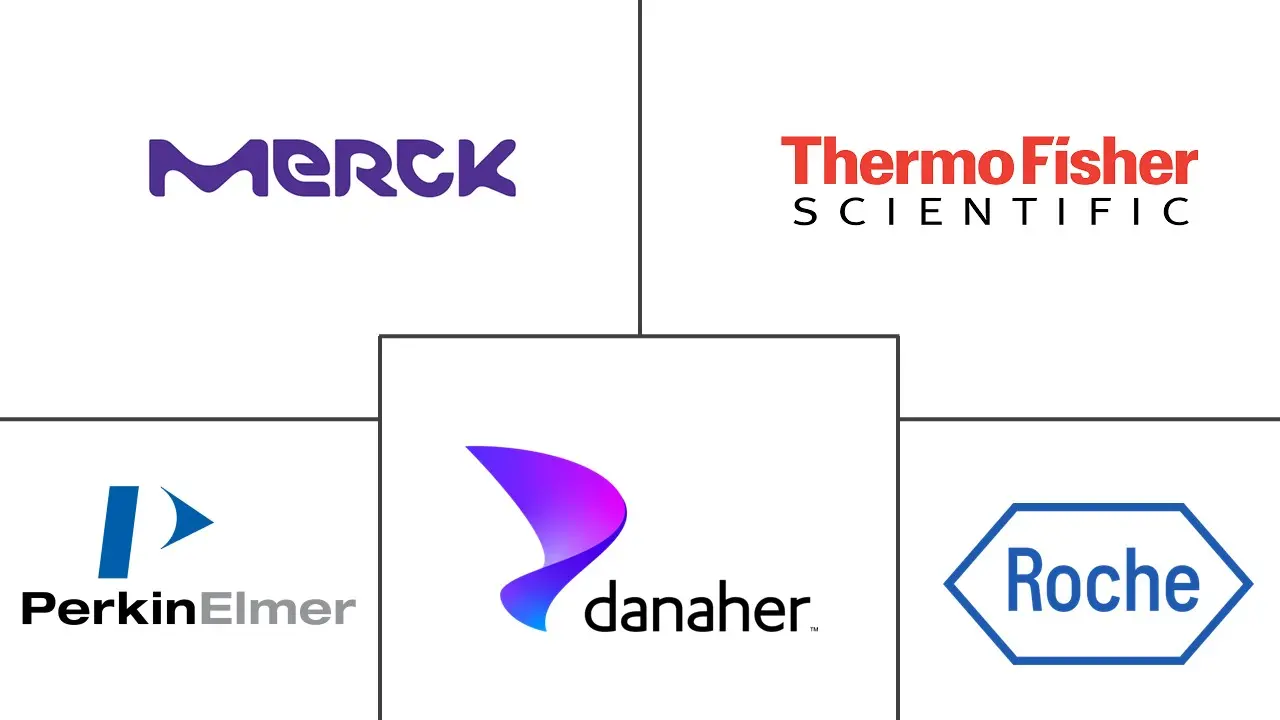Protein Labeling Market Size and Share
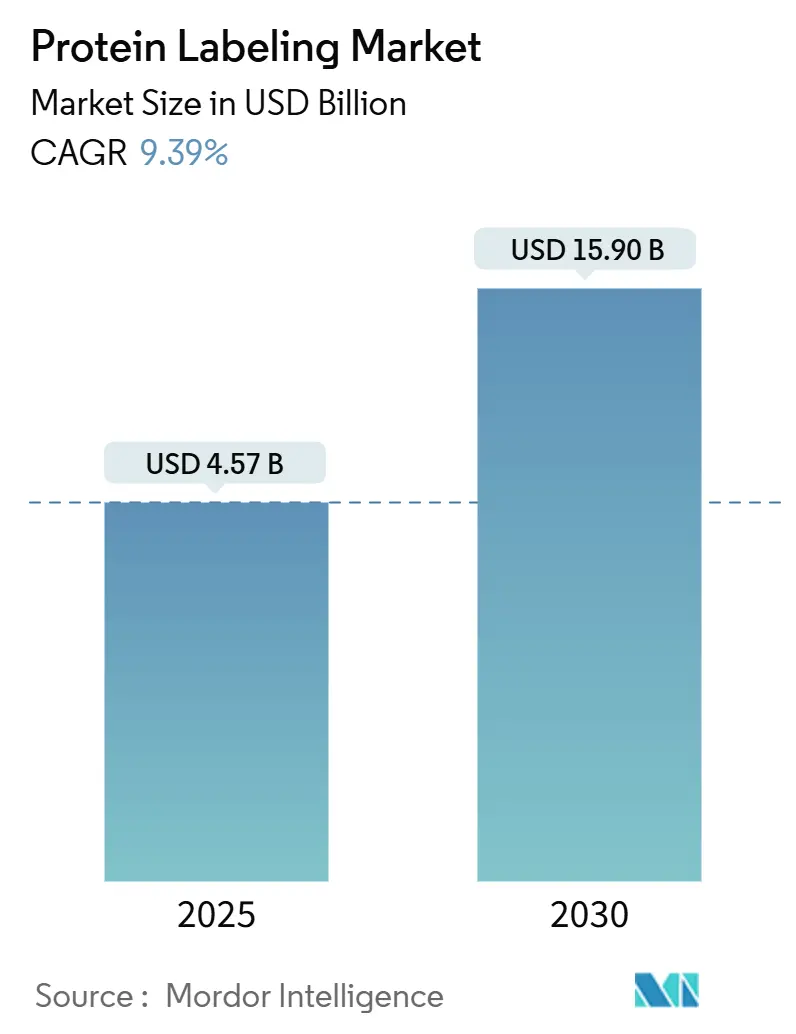
Protein Labeling Market Analysis by Mordor Intelligence
The protein labelling market is currently valued at USD 2.92 billion in 2025 and is forecast to reach USD 4.57 billion by 2030, translating into a steady 9.39% CAGR. Demand is propelled by breakthroughs that allow site-specific tags with minimal impact on protein conformation, an essential requirement for today’s advanced proteomics, live-cell imaging and biotherapeutic workflows. Widening use of artificial-intelligence tools for structure prediction, a growing pipeline of antibody-drug conjugates and the migration of complex bioconjugation tasks to specialist CDMOs jointly broaden commercial opportunities. At the same time, capital-intensive analytical platforms and evolving regulations around radio-labelled conjugates remain practical hurdles. Competitive intensity is rising as incumbents look to differentiate via proprietary chemistries, integrated service models and strategic alliances with drug developers.
Key Take Aways
- By product type: Reagents and kits led with 71.13% of protein labelling market share in 2024, while services are projected to expand at a 10.47% CAGR through 2030.
- By application: Immunological techniques accounted for 34.37% share of the protein labelling market size in 2024, but cell-based assays are advancing at an 11.13% CAGR between 2025-2030.
- By labelling method: In-vitro approaches held 60.07% of the protein labelling market size in 2024; in-vivo techniques are growing faster at a 12.23% CAGR.
- By end user: Pharmaceutical and biotechnology companies commanded 44.90% share of the protein labelling market size in 2024, whereas CROs/CDMOs record the highest projected CAGR at 13.07% through 2030.
- By geography: North America led with 37.90% revenue share in 2024; Asia–Pacific is forecast to post the quickest regional CAGR of 11.57% over 2025-2030.
Global Protein Labeling Market Trends and Insights
Drivers Impact Analysis
| Restraint | ( ~ ) % Impact on CAGR Forecast | Geographic Relevance | Impact Timeline |
|---|---|---|---|
| Limitations Associated with Protein Labelling Assays and Methods | -0.7% | Global | Medium term (2-4 years) |
| Regulatory complexity around protein–radioisotope conjugate | -0.6% | North America, Europe, Japan | Long term (≥ 4 years) |
| High capital cost of high-resolution mass-spectrometry work-flows | -0.5% | Emerging markets, smaller research institutions globally | Medium term (2-4 years) |
| Limited shelf-life and stability issues of many labelled reagents | -0.4% | Global, more pronounced in regions with challenging infrastructure | Short term (≤ 2 years) |
| Source: Mordor Intelligence | |||
Expanding R&D in proteomics and genomics
Advances in high-resolution mass spectrometry and AI-driven modelling have sharply raised the volume and depth of protein characterisation studies. The release of ESM-3 and AlphaFold 3 in 2024 improved structure-prediction accuracy, enabling researchers to pinpoint accessible residues for selective tagging. Funding programs across the United States and Europe now prioritise multi-omics pipelines that depend on robust labelling chemistries for quantitation and spatial mapping. These dynamics sustain premium pricing for next-generation probes and herald broader uptake of high-throughput workflows in academic cores and translational-medicine centres.
Growing application in drug discovery and development
Roughly 40% of investigational drugs now focus on historically undruggable proteins, elevating the role of homogeneous, site-specific labelling. Antibody-drug conjugate pipelines, currently exceeding 360 clinical studies, require precise linker-payload ratios for efficacy. Targeted protein degradation platforms similarly depend on live-cell tags that monitor real-time proteolysis. These use cases expand addressable demand across reagents, instrumentation and custom-conjugation services.
Rising outsourcing to CDMOs/CROs
Pharmaceutical companies are streamlining CapEx by delegating conjugation, fill-finish and analytics to specialised partners. Samsung Biologics’ 2024 agreement to supply end-to-end ADC services for AstraZeneca typifies the model, ensuring access to GMP-grade labelling while compressing timelines. Asia-Pacific providers gain traction by coupling cost efficiencies with expanding regulatory credentials, accelerating double-digit revenue growth.
Increasing use of fluorescence-based techniques
Super-resolution microscopy now routinely achieves sub-10 nm detail thanks to quantum-dot and organic-dye innovations[1].Source: “Site-specific protein labeling strategies for super-resolution microscopy,” ScienceDirect, sciencedirect.com Researchers integrate multiplexed panels to visualise protein networks, boosting reagent consumption and adding impetus to instrument upgrades.
Restraint Impact Analysis
| Restraint | ( ~ ) % Impact on CAGR Forecast | Geographic Relevance | Impact Timeline |
|---|---|---|---|
| Limitations Associated with Protein Labelling Assays and Methods | -0.7% | Global | Medium term (2-4 years) |
| Regulatory complexity around protein–radioisotope conjugate | -0.6% | North America, Europe, Japan | Long term (≥ 4 years) |
| High capital cost of high-resolution mass-spectrometry work-flows | -0.5% | Emerging markets, smaller research institutions globally | Medium term (2-4 years) |
| Limited shelf-life and stability issues of many labelled reagents | -0.4% | Global, more pronounced in regions with challenging infrastructure | Short term (≤ 2 years) |
| Source: Mordor Intelligence | |||
Limitations of protein labelling assays and methods
Large fluorescent tags above 25 kDa altered sub-cellular localisation in 42% of tested proteins, and nanobody conjugates showed 38% variability in binding efficiency across labs. Such inconsistencies raise validation requirements, extend project timelines and increase consumable usage, particularly in regulated environments.
Regulatory hurdles for protein-radioisotope conjugates
The FDA’s phased oversight of laboratory-developed tests beginning July 2024 introduces new compliance checkpoints for radio-label workflows[2].Source: “Medical Devices; Laboratory Developed Tests,” Federal Register, federalregister.gov Comparable provisions in the EU heighten documentation and facility-licensing costs, restricting adoption to well-funded centres.
Segment Analysis
By Product: Services accelerate while reagents anchor growth
Reagents and kits accounted for 71.13% of protein labelling market revenues in 2024, underscoring their essential role in day-to-day workflows across discovery, diagnostics, and manufacturing. Ready-to-use chemistries simplify protocol standardisation and support reproducibility, keeping demand resilient even as new techniques emerge. Continuous improvements in dye brightness and click-ready handles sustain incremental pricing power and entice repeat purchases.
The services segment, however, is outpacing headline growth at a 10.47% CAGR. This surge reflects the escalating technical complexity of antibody-drug conjugation, targeted degradation probes and live-animal imaging agents that exceed many in-house capabilities. CDMOs are adding dedicated 1,000–2,000 L suites, such as Lonza’s 2024 expansion in Visp, to accommodate large-scale payload conjugation and fill-finish tasks. The protein labelling market size for outsourced projects is projected to expand steadily as pipeline sponsors seek rapid, GMP-compliant solutions.
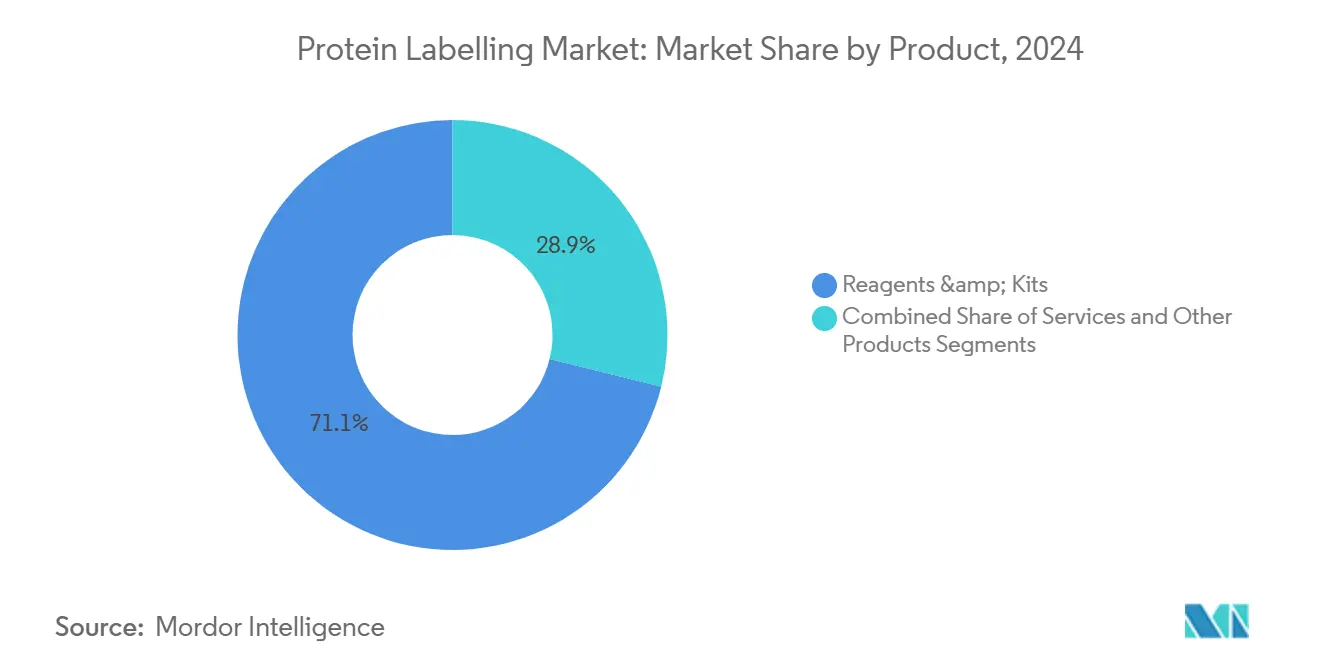
Note: Segment shares of all individual segments available upon report purchase
By Application: Cell-based assays gather momentum alongside immunological staples
Immunological techniques remained the largest slice of the protein labelling market with a 34.37% share in 2024, benefiting from decades of optimisation in ELISA, western blot and immunohistochemistry. High throughput and clinically validated protocols ensure enduring relevance in biomarker verification, lot-release testing and routine pathology.
Cell-based assays, however, record the most rapid advance at 11.13% CAGR as researchers prioritise physiologically relevant readouts in oncology, neurology and regenerative medicine. Fluorescent-probe portfolios from Thermo Fisher enable real-time monitoring of receptor activation, trafficking and complex assembly. The protein labelling market share captured by dynamic live-cell platforms is set to widen as automated imaging and high-content analytics permeate screening laboratories.
By Labelling Method: In-vivo approaches reshape real-time visualisation
In-vitro chemistries continue to dominate with 60.07% of the protein labelling market in 2024, valued for precise stoichiometry and straightforward quantitation. Diagnostics and structural biology still rely heavily on purified-protein modifications that demand controlled environments.
In-vivo labelling registers a faster 12.23% CAGR, driven by advances in genetic code expansion, enzyme-mediated tagging and ultrafast CuRVE labelling that spans intact 3D tissues.[3]Source: “MIT method enables ultrafast protein labeling of tens of millions of cells in 3D tissues,” MIT News, news.mit.edu These techniques enable researchers to map protein dynamics in native cellular contexts, critical for neurobiology and tumour micro-environment studies. The protein labelling market size attached to real-time intracellular applications will therefore widen progressively through 2030.
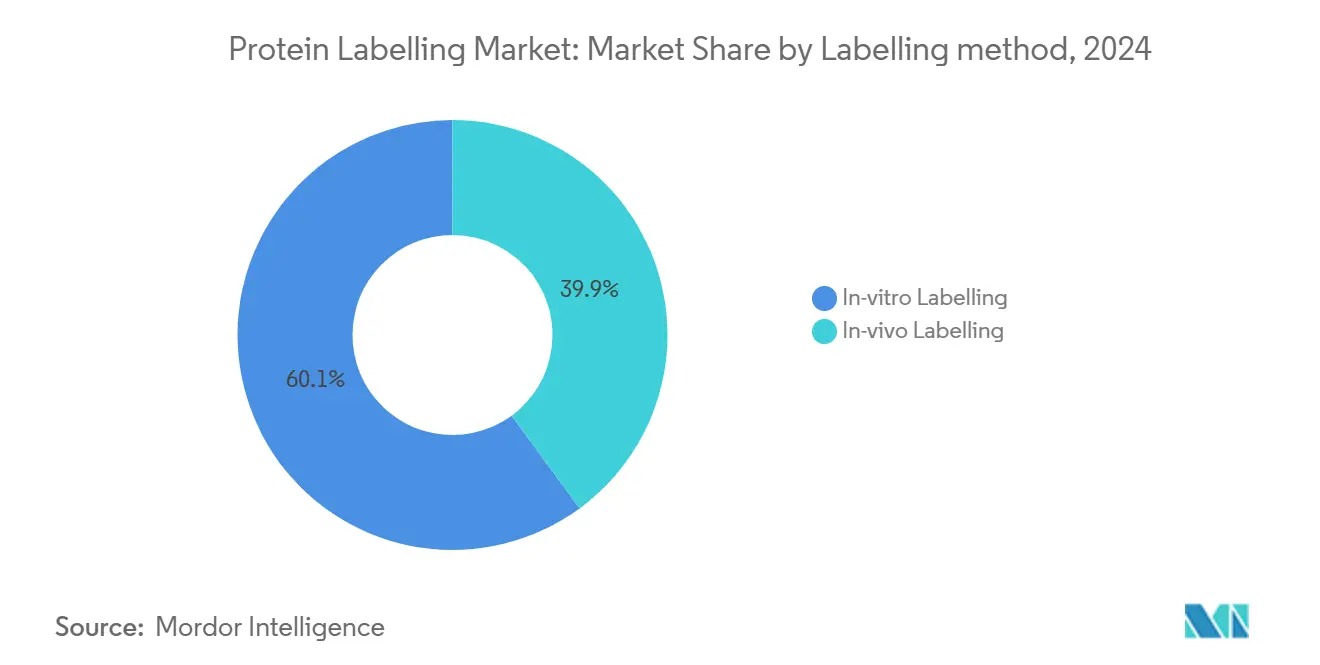
Note: Segment shares of all individual segments available upon report purchase
By End User: CROs/CDMOs emerge as prime growth engine
Pharmaceutical and biotech firms held 44.90% of 2024 revenues, validating the centrality of protein tagging from target identification through late-stage development. Rising venture funding, such as Syncell’s USD 15 million Series A to expand its Microscoop spatial-proteomics platform, injects fresh demand for custom reagents and analytics.
Nonetheless, CROs and CDMOs show the sharpest climb at 13.07% CAGR as sponsors externalise conjugation and GMP analytics. Partnerships like GenNext-Thermo Fisher that integrate advanced footprinting and Orbitrap LC-MS combine best-in-class tools with regulatory expertise, cementing the outsourcing model’s appeal. Academic institutes remain essential consumers for fundamental inquiries, while diagnostics labs favour rapid-turnaround immunoassays using pre-validated tagging kits.
Geography Analysis
North America generated 37.90% of 2024 revenues, supported by robust NIH funding, a dense biopharma cluster and early adoption of next-generation labelling technologies. MIT’s CuRVE breakthrough, capable of labelling tens of millions of cells in a single day, exemplifies regional leadership in disruptive methodology[3]Source: “MIT method enables ultrafast protein labeling of tens of millions of cells in 3D tissues,” MIT News, news.mit.edu. A high cadence of FDA approvals for ADCs and radio-immunoconjugates further anchors commercial momentum.
Europe ranks second, buoyed by Horizon Europe grants and strong biomanufacturing corridors in Germany, the United Kingdom and France. Sartorius’ acquisition of Polyplus expanded the continent’s vector-production capabilities, necessitating advanced tagging for viral envelope proteins. Regulatory harmonisation is progressing, yet divergent approaches to radio-isotope handling keep market entry costs elevated.
Asia-Pacific is the fastest-growing arena, advancing at an 11.57% CAGR. Chinese CDMOs such as WuXi Biologics report vibrant demand for conjugation formats branded under WuXiBody and associated linker chemistries. National industrial policies, including China’s 14th Five-Year Plan and India’s BIRAC initiatives, funnel capital into proteomic infrastructure, although uneven access to high-end MS platforms persists. South Korea’s rapid scale-up of antibody-drug conjugate facilities, backed by Samsung Biologics, further cements regional ascent.
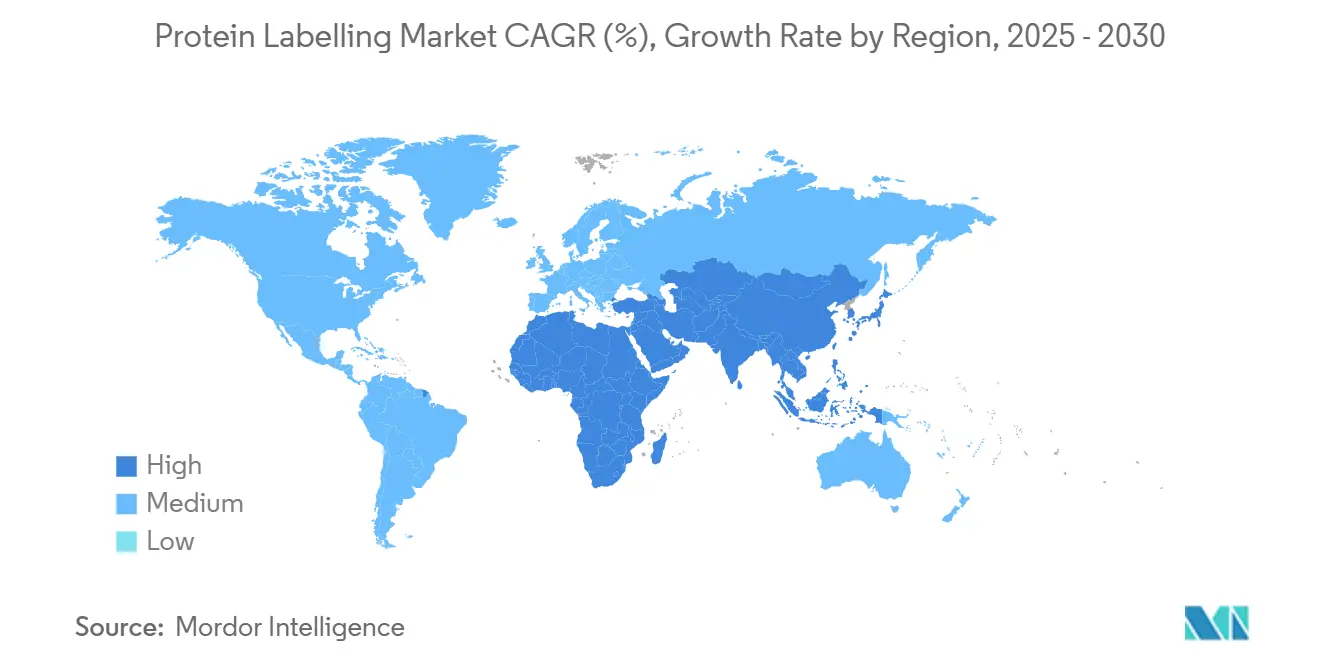
Competitive Landscape
The top five suppliers collectively capture nearly half of global revenues, pointing to a moderately concentrated field. Thermo Fisher Scientific leads with an end-to-end portfolio of fluorescent probes, click-chemistry kits, microscopes and LC-MS systems. Merck KGaA follows, leveraging its legacy reagent brands to supply high-purity substrates for bioorthogonal tagging. Danaher’s Cytiva and Beckman Coulter units strengthen its position via bioprocess solutions and advanced flow-cytometry analytics.
Strategic differentiation hinges on proprietary site-specific chemistries and integrated service offerings. Lonza’s twin 1,200 L conjugation suites allow seamless scale-up from preclinical to commercial batches, while Bio-Rad broadens its super-resolution imaging reagents for multiplex panel design. Recent moves include Sartorius’ launch of the Octet R8e BLI system that captures binding-kinetics data more rapidly than previous models.
Alliances between tech innovators and drug developers continue to proliferate. EditCo Bio’s licensing of Promega’s HiBiT, HaloTag and NanoLuc platforms streamlines CRISPR knock-in workflows, shortening build-test iterations. Prism BioLab’s tie-up with Elix integrates AI-driven compound design with peptide-mimetic screening, expanding the addressable client base for selective PPI inhibitors.
Protein Labeling Industry Leaders
-
Thermo Fisher Scientific Inc
-
Merck KGaA
-
Perkinelmer Inc
-
Danaher Corporation
-
F. Hoffmann-La Roche AG
- *Disclaimer: Major Players sorted in no particular order
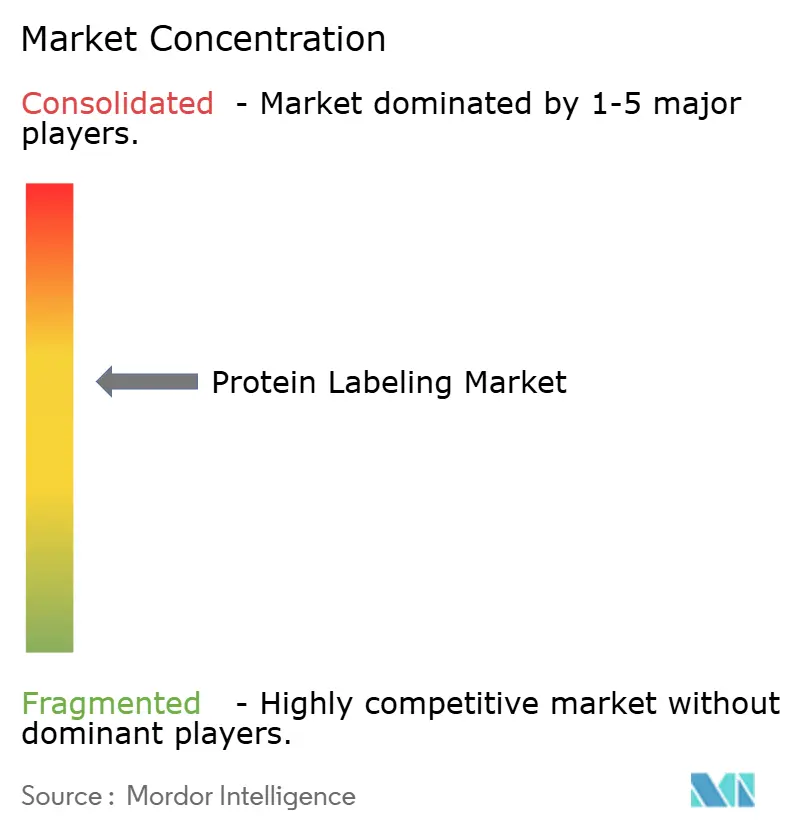


Recent Industry Developments
- May 2025: GenNext Technologies partners with Thermo Fisher to integrate AutoFox footprinting with Orbitrap LC-MS solutions
- May 2025: Sartorius introduces the Octet R8e biolayer-interferometry system for high-throughput kinetic analysis
- April 2025: EditCo Bio secures rights to Promega’s HiBiT, HaloTag and NanoLuc technologies to enhance CRISPR knock-ins.
- April 2025: Prism BioLab and Elix collaborate on AI-accelerated peptide-mimetic drug discovery.
Research Methodology Framework and Report Scope
Market Definitions and Key Coverage
Our study defines the protein labeling market as all commercial sales of reagents, ready-to-use kits, and fee-based custom conjugation services that covalently or non-covalently tag proteins in vitro or in vivo for detection, purification, or functional studies across academic, biopharma, diagnostic, and contract research laboratories.
Scope exclusion: Bulk commodity amino-reactive chemicals sold for downstream manufacturing and fully label-free detection platforms are outside the count.
Segmentation Overview
- By Product
- Reagents and Kits
- Services
- Other Products (Spin columns, Resins, etc.)
- By Application
- Immunological Techniques
- Cell-based Assays
- Fluorescence Microscopy
- Protein Microarrays
- Mass Spectrometry
- By Labelling Method
- In-vitro Labelling
- In-vivo Labelling
- By End User
- Pharmaceutical and Biotechnology Companies
- Contract Research and Manufacturing Organisations (CROs/CDMOs)
- Academic and Research Institutes
- Clinical Diagnostics Laboratories
- By Geography
- North America
- United States
- Canada
- Mexico
- Europe
- Germany
- United Kingdom
- France
- Italy
- Spain
- Rest of Europe
- Asia-Pacific
- China
- Japan
- India
- South Korea
- Australia
- Rest of Asia-Pacific
- Middle East and Africa
- GCC
- South Africa
- Rest of Middle East and Africa
- South America
- Brazil
- Argentina
- Rest of South America
- North America
Detailed Research Methodology and Data Validation
Primary Research
Mordor analysts conducted structured calls and short surveys with bench scientists, procurement managers at CRO/CDMOs, and regional distributors across North America, Europe, and Asia. These conversations clarified typical kit replacement cycles, emerging labeling workflows (e.g., click-ready unnatural amino acids), and average selling prices, which were pivotal for stress-testing desk assumptions.
Desk Research
We began by mapping export codes for biochemical reagents in UN Comtrade, reviewing NIH RePORTER grant outlays, and extracting assay kit shipment data published by bodies such as Europe's CORDIS and Japan's METI. Patent activity on site-specific chemistries was pulled from Questel, while pricing and volume cues came from SEC-filed 10-Ks, investor decks, and open-access journals in Proteomics and Analytical Chemistry. Dow Jones Factiva and D&B Hoovers supplemented revenue splits of privately held dye and tag suppliers, giving us baseline input costs and channel mix. These sources, illustrated above, are not exhaustive; many additional public datasets and gray literature fed into evidence screens and cross-checks.
Market-Sizing & Forecasting
We anchor the top-down model on observed reagent and kit imports plus domestic production, then reconcile totals with a bottom-up roll-up of sampled supplier revenues and channel checks. Core variables include: annual PubMed publications mentioning "fluorescent protein tag," UN Comtrade HS 3822 reagent tonnage, average NHS-ester dye ASPs, count of antibody-drug conjugate clinical trials, and regional R&D spend indexed by OECD biotech statistics. A multivariate regression blends these drivers, and an ARIMA overlay captures cyclical reorder patterns before projecting through 2030. Where bottom-up estimates undershoot or overshoot by over five percent, we iteratively adjust volumes or ASPs until deltas fall within that threshold.
Data Validation & Update Cycle
Outputs flow through three-layer checks: automated variance flags, peer analyst review, and final sign-off. Reports refresh annually; interim events such as large M&A deals or regulatory shifts trigger expedited updates, ensuring clients receive the most current baseline.
Why Our Protein Labelling Baseline Commands Reliability
Published figures often diverge because firms choose different product baskets, extrapolate from dated CAGRs, or refresh data irregularly. Our disciplined scoping, live price sampling, and primary corroboration limit such drift.
Key gap drivers include exclusion of fee-based conjugation services by some publishers, reliance on legacy dye price decks, or use of flat volume growth across high-growth Asian labs. Mordor's model, refreshed each year and stress-tested with on-ground interviews, therefore yields a balanced midpoint.
Benchmark comparison
| Market Size | Anonymized source | Primary gap driver |
|---|---|---|
| USD 2.92 B (2025) | Mordor Intelligence | - |
| USD 2.62 B (2024) | Global Consultancy A | omits custom service revenues and applies static ASP deflators |
| USD 2.67 B (2024) | Industry Journal B | limited primary validation; growth derived from generic proteomics CAGR |
| USD 2.35 B (2024) | Data Tracker C | reagent-only scope; excludes Asia-Pacific outsourcing spend |
In sum, the side-by-side shows that Mordor's carefully bounded scope, variable-based modeling, and yearly refresh cadence produce a dependable baseline that decision-makers can trace to transparent inputs and reproducible steps.


Key Questions Answered in the Report
1. What is the projected value of the protein labelling market by 2030?
The market is expected to reach USD 4.57 billion by 2030, reflecting a 9.39% CAGR
2. Which region shows the fastest growth in the protein labelling market?
Asia–Pacific leads with an 11.57% CAGR, fuelled by expanding CDMO capabilities and supportive government initiatives.
3. Why are CROs and CDMOs gaining traction in the protein labelling industry?
Sponsors outsource complex conjugation to access specialised expertise, reduce capital outlays and compress development timelines, driving a 13.07% CAGR for this segment.
4. How do site-specific labelling technologies benefit drug discovery?
Precise tags improve homogeneity in antibody-drug conjugates and enable real-time monitoring of targeted protein degradation, thereby enhancing therapeutic efficacy.
5. What technical advances underpin the rise of in-vivo labelling?
Genetic code expansion, enzyme-mediated chemistries and MIT’s CuRVE method allow rapid, uniform tagging in living tissues without disrupting protein function.
6. Which restraint most significantly limits wider adoption of advanced protein labeling tools?
High capital costs for top-tier mass-spectrometry platforms remain the chief barrier, particularly in emerging markets with constrained research budgets.
Page last updated on:
